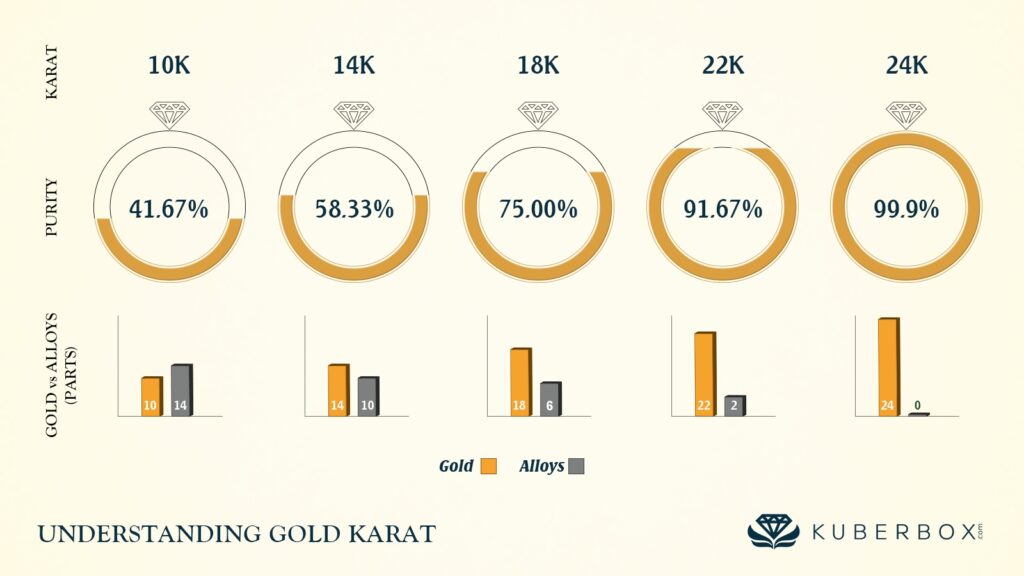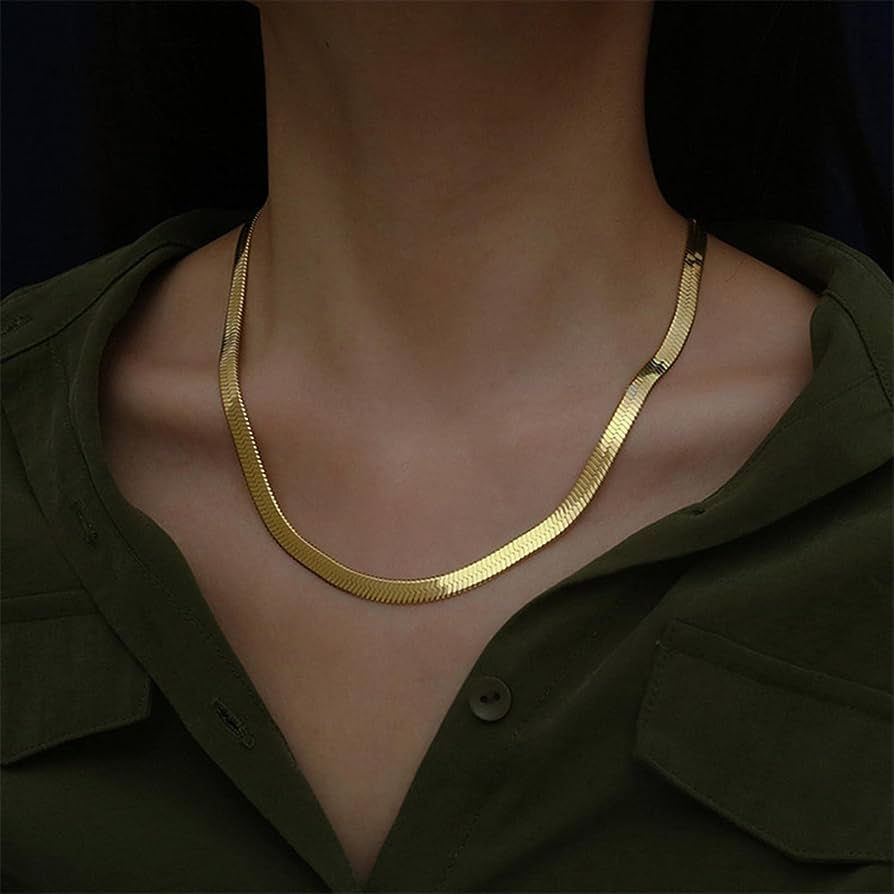In the world of precious metals and jewelry, one term that you’re bound to encounter is ‘karat,’ often abbreviated as ‘K’ or ‘kt.’ The karat is a measure used to represent the purity of gold. But what exactly does this mean, and how does it impact the quality and value of gold? While pure gold is symbolized as 24 karats, you’ll often find gold jewelry and other items in varying degrees of purity, such as 18-karat, 14-karat, or 10-karat gold. Each karat represents a different ratio of gold to other metals in an item, thus influencing its durability, color, and value. In this article, we’ll delve into the concept of gold karats, helping you understand their significance in the world of gold. Before diving in, don’t forget to check our best Russian gold coins! Now, what is gold Karat?

What is Gold Karat?
Gold karat is a unit of measurement used to assess the purity of gold, which carries significant implications in both the realms of chemistry and investing.
From a chemistry perspective, gold, symbolized as ‘Au’ on the periodic table, is a transition metal that’s quite malleable and ductile in its pure form. Gold’s atomic number is 79, and its atomic weight is approximately 197. Pure gold is relatively soft and not particularly suited to everyday wear and tear, which is why it’s often alloyed with harder metals for use in jewelry.
The karat system was developed to quantify the amount of gold in an alloy. A karat is defined as 1/24 part of pure gold by weight. Therefore, 24-karat gold is pure gold. If an item is made from 18-karat gold, that means it contains 18 parts gold and 6 parts of other metals, making up a total of 24 parts. This equates to 75% gold content. The other metals used in the alloy can include silver, copper, zinc, or nickel, and these can affect the color and hardness of the final product. For instance, more copper results in a redder color, often referred to as rose gold.
From an investment standpoint, the karat weight has implications for the value of the gold item. Higher karat gold is more valuable because it contains a higher percentage of gold. For example, an ounce of 24-karat gold will be worth more than an ounce of 14-karat gold.
However, it’s also important for investors to note that higher karat gold is softer and more prone to damage. This can be a factor if you’re investing in physical gold items like jewelry or coins that might be handled frequently. In such cases, a lower karat, like 14-karat or 18-karat, might be preferable because it’s more durable, despite having a lower gold content.
Furthermore, different countries have different preferences and standards when it comes to the karat of gold used in jewelry. For example, 14-karat and 18-karat gold are common in the United States, while 22-karat gold is more typical in parts of Asia. This cultural aspect can influence the marketability and resale value of gold items in different regions.
In summary, understanding gold karats is essential both for understanding the physical properties of gold items and for making informed decisions about gold as an investment. The right balance of purity and practicality will depend on your individual circumstances and goals.
How to Evaluate the Gold Karat?
Evaluating the karat of a gold piece involves determining its purity, and there are several ways to do this.
- Hallmarks: The simplest method is to look for a hallmark, also known as a stamp. Most gold jewelry will have a small stamp that indicates its karatage. For example, an 18-karat gold piece might be stamped with “18K,” “18KT,” “750” (indicating 75% gold), or similar. Note that hallmarks can be faked, so they should not be your only method of verification, particularly for high-value items.
- Professional Appraisal: If you’re not sure about an item’s authenticity or if it’s unmarked, consider getting it professionally appraised. An experienced jeweler or precious metal dealer can conduct tests to determine the karat of a gold item. These tests may include a scratch test, where the item is rubbed on a stone and the resulting streak is tested with acid, or more advanced methods such as X-ray fluorescence (XRF).
- Home Testing Kits: For those who prefer to do their own testing, home testing kits are available. These typically involve a series of acid tests, where a small amount of the gold item is scratched onto a testing stone and different strengths of acid are applied to see if the gold dissolves. It’s crucial to follow safety precautions and directions if using an acid test.
- Electronic Gold Testers: These devices can evaluate the karat of a gold piece without damaging it. They measure the electrical conductivity of the metal to estimate its purity. While these can be convenient and easy to use, they may not be as accurate as professional testing methods, especially for complex alloys or plated items.
Remember, assessing the karat of gold is important not only for valuing the item but also for understanding its properties. Higher-karat gold is more valuable but softer and more prone to damage, while lower-karat gold is harder and more durable but has a lower gold content. Whether you’re buying, selling, or investing in gold, knowing how to evaluate the karats can help you make informed decisions.
The Different Karats: a Comparison
Let’s look at some of the common gold karats and their characteristics. For the prices, please note that these can fluctuate significantly depending on the current market price for gold and other factors such as craftsmanship, brand, and condition in case of jewelry. Hence, the prices mentioned here would be approximations and can change.
| Karat | Purity | Alloyed With | Hardness | Typical Uses |
|---|---|---|---|---|
| 24K | 99.9% gold | No other metals | Very Soft | Bullion, Investment Gold |
| 22K | 91.7% gold | Copper, Silver, Zinc | Soft | High-quality Jewelry, Coins |
| 18K | 75.0% gold | Copper, Silver, Palladium | Medium | Fine Jewelry |
| 14K | 58.3% gold | Copper, Silver, Zinc, Nickel | Fairly Hard | Jewelry, Watches |
| 10K | 41.7% gold | Copper, Silver, Palladium, Nickel, Zinc | Hard | Jewelry, Decorative Items |
Each karat type has different properties and uses due to their varying gold content and the other metals used in the alloy. Lower karat golds are more durable and resistant to wear and tear, which is why they’re often used for items like jewelry and watches. Higher karat golds, while less durable, are prized for their higher gold content and are often used in investment and high-quality jewelry.
The Gold Karats in Jewellery
Here are a few examples of jewelry pieces and the corresponding karats they are typically made with:
- 24K Gold Necklace: This piece of jewelry is made with pure gold, giving it a rich and bright yellow color. Due to its high gold content, it’s usually more expensive. However, due to its softness, it may be more prone to scratching and bending, so it’s typically used for special occasions rather than everyday wear.
- 22K Gold Wedding Band: A wedding band made of 22K gold is slightly less pure but still maintains a bright yellow color. It’s used often in cultures where high-karat gold jewelry is traditional for wedding pieces.
- 18K Gold Diamond Engagement Ring: The gold setting of an engagement ring is often made of 18K gold. It provides a nice balance between gold content and durability, making it ideal for a ring that is worn every day. Plus, the bright gold color sets off the sparkle of the diamond beautifully.
- 14K Gold Hoop Earrings: 14K gold is commonly used for earrings. It’s durable enough to withstand regular wear and tear, and it’s also less expensive than higher-karat gold, making it a popular choice for many types of jewelry.
- 10K Gold Charm Bracelet: A charm bracelet made of 10K gold is strong and durable, making it suitable for everyday wear. It’s also more affordable due to the lower gold content.

Remember, the karat of gold you choose for your jewelry depends on many factors, including your budget, the color of gold you prefer, and the durability you need based on how often you plan to wear the piece.
Conclusion
In the context of jewelry, karats (denoted by “K”) signify the amount of gold present in the metal. Pure gold is 24K, meaning it contains 100% gold, but due to its softness and malleability, it is often alloyed with other metals to improve its durability, especially for jewelry.
Lower karat gold, such as 18K, 14K, and 10K, include more alloy metals, making the gold harder, more durable, and less expensive. However, they contain less gold and are therefore less valuable. The choice between them usually depends on personal preference, balancing factors such as color, strength, potential for skin sensitivity, and cost.
To sum up, karats are a key aspect to consider when purchasing gold products, as they significantly impact the material’s quality, value, and durability. Be sure to make an informed choice based on your needs, preferences, and budget.
